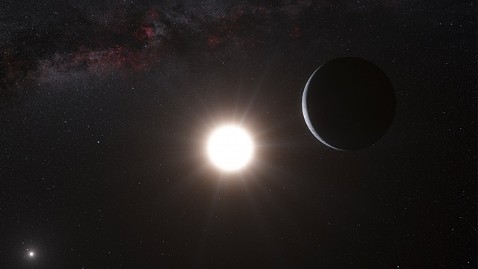Alpha Centauri, Nearest Star, Has Earth-Sized Planet

Artist's conception of planet orbiting Alpha Centauri B. Image: ESO/L. Calcada
How many science fiction stories have been written about Alpha Centauri, the closest star system to our own? How many serious scientists, in their quest to determine just how lonely we are in the universe, have wondered whether there are planets there, only four light-years away?
The first results are in - and yes, there is at least one planet orbiting Alpha Centauri B, one of the three stars clustered together there. European astronomers, using a 3.6 meter telescope at the La Silla Observatory in Chile, report it is remarkably small - about as massive as Earth. Worlds that small have been beyond earthlings' capacity to detect them until just very recently.
Let's get some details out of the way quickly. The newly found planet is probably hellish, only about 4 million miles from its host star (we're 93 million miles from ours). It's also fast, completing one orbit - one "year" - in only 3.2 of our days.
For now, the most remarkable thing about the planet, say the astronomers, is that they found it at all. It is much too distant to be seen directly. Instead, they watched the planet make its star wobble slightly, pulled around by the planet's gravity as it circled from one side to the other.
Their measurements showed the star moved from side to side at a top speed of 1.8 km (about 1.1 miles) per hour - "about the speed of a baby crawling," they said.
"It's an extraordinary discovery and it has pushed our technique to the limit," said Xavier Dumusque of the Geneva Observatory in Switzerland, who is lead author of the paper reporting the find in this week's edition of the journal Nature.
So the astronomers were able to detect the little world over a distance of 25 trillion miles, but just barely. They kept watching for four years until they were sure.
It's hardly a twin of Earth, but it is a neighbor of sorts, one more sign that the Milky Way galaxy is thick with planets.